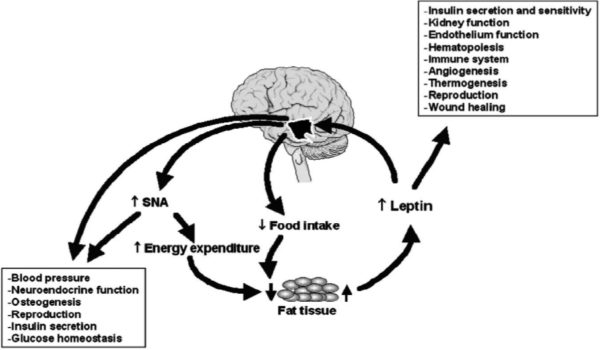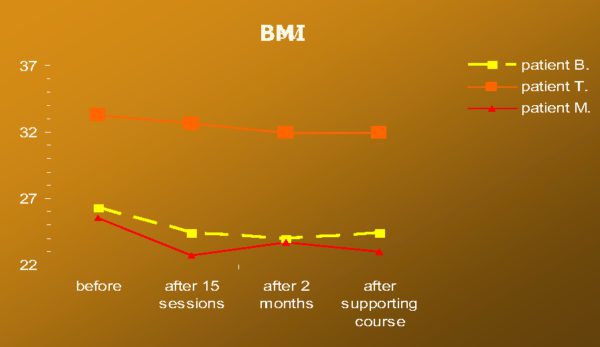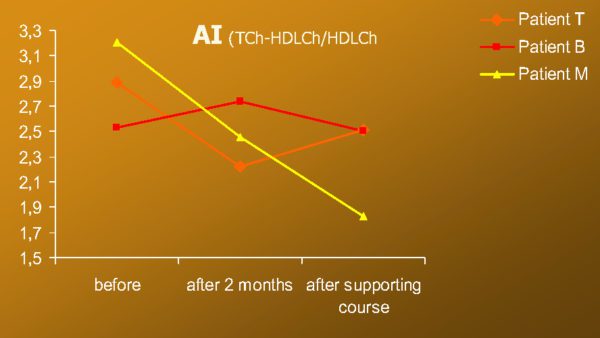ALFA SPA Company
P.K.Anokhin
Research Institute of Normal Physiology
Moscow, Russia, 2007
“Obesity can change cardiac autonomic nervous response, meaning that the mechanism by which obesity increases cardiac mortality would be explained, at least partially”.
The Journal of the American Board of Family Practice 18:97-103 (2005)
Jeong A Kim, Yong-Gyu Park, Kyung-Hwan Cho et al. Heart Rate Variability and Obesity Indices: Emphasis on
the Response to Noise and Standing:

FIG. Role of leptin in the regulation of body weight and other functions. Leptin is secreted by adipocytes and circulates in the blood in a concentration proportional to fat mass content. Action of leptin on its receptor present in the hypothalamus inhibits food intake and increases energy expenditure through stimulation of sympathetic nerve activity (SNA). Leptin modulates different other functions by direct peripheral action in various tissues or through the modulation of SNA.
Design of the Study
Number and general characteristics of the patients to be involved randomly to the study:
Study group — 17 persons (age 28 — 56 years), BMI = 32,6±3,2 (28,2-36,2)
Control group — 8 persons (age 30 – 54 years), BMI = 29,6+1,9 (26,2-34,2)
Scheme of the usage of SlimLine Spa capsule:
Total amount of the sessions 15 (one in 2-3 days) in 35-40 days
Control group patients also have passed 15 sessions in the capsule, but they were simulating only (relaxing music, temperature around 28-30C, face ventilation by normal cooled air).
All the participants have signed “informed written consent for participation” – to pass all the recommended sessions, not to change their usual lifestyle, nutritional habit, not to use any remedies, food supplements for weight loss, and to try to have the last meal not later than 20-00.
Main Stages of the Complex Medical and Physiological Examinations:
2 main dates for examination:
* on the day when the patient gives his/her formal written consent to participate in the studies (before treatment in Oxy SPA capsule)
* on the next day after the course of the treatment-rehabilitation process with the Oxy SPA capsule (at the end occ the rehabilitation program).
Complex Examination:
– clinical observation and testing with the use of:
– psychological (internationally verified and valid scales),
– physiological
– biochemical methods
Psychological Examination
1. Studies of the personality:
a) methods of evaluation of anxiety, anger, depression as personal characteristics (Ch. Spielberger) before and after the course of rehabilitation.
3. Examination of the emotional status:
– methods for evaluation of anxiety, anger, depression as a current state — before & after the sessions, 2 times
– scale of differential emotions, “Well-being scale” 2 times.
Physiological Examinations
1. Integral Bioelectric impedansometry with the control of the body weight (BM, kg), BMI, cell mass and fat mass in kg and % to BM
2. Study of the peculiarities of the autonomic blood circulation:
– measurement of BP, heart rate,
– registration of pneumo- and cardiorhythmograms (5-min epoch) with the analysis of the heart rate variability parameters (HRV-analysis*), calculation of stress indices.
* The analysis of HRV was performed with the use of a device (“neurosoft”, Ivanovo, Russia) that satisfies the standards of the European Society of Cardiology and the North American Society of Pacing and Electrophysiology.
Biochemical Examination
Blood sampling — 2 times during the rehabilitation course:
1. Hormonal status: cortisol, insulin, GH, IGF-1
2. Glucose, Mmo1/1
3. Cholesterol, Tryglicerides,
Obesity Indices at rest before and after the rehabilitation course
No |
Parameter |
Experimental group (n=15) |
Control group (n=17) |
||
|---|---|---|---|---|---|
| Before the cource | After | Before the cource | After | ||
| 1 | Weight, Kg | 90,44±1,84 | 87,41±1,73* | 78,20±3,43 | 78,34±3,49 |
| 2 | BMI | 33,66±3,65 | 32,45±3,76 | 29,52±1,19 | 29,67±1,24 |
| 3 | Fat Mass, % | 28,64±2,80 | 21,75±3,47* | 26,66±3,65 | 30,31±2,83 |
| 4 | Cell Mass, Kg | 42,13±3,11 | 43,47±4,69 | 41,44±6,19 | 38,39±4,38 |
| 5 | Cell Mass, % | 65,68±1,95 | 67,81±3,11 | 65,50±1,89 | 65,79±3,37 |
Biochemical and Hormonal Parameters Before and After the Rehabilitation Course
No |
Parameter |
Experimental group (n=15) |
Control group (n=17) |
||
|---|---|---|---|---|---|
| Before the cource | After | Before the cource | After | ||
| 1 | Glucose, Mnol/L | 5,75±0,31 | 5,04±0,22* | 5,29±0,11 | 5,62±0,13 |
| 2 | CholesterolMnol/L | 5,37±0,11 | 4,91±0,09 | 5,75±0,48 | 5,66±0,51 |
| 3 | IGF, ng/ml | 245,48±13,9 | 263,24±16,99* | 231,73±30,71 | 212,90±17,28 |
| 4 | HGH, ng/ml | 2,13±0,99 | 3,89±1,34 | 2,04±0,84 | 3,47±1,49 |
NB: optimal values of blood plasma lipid parameters according to the European recommendations of the Third revision, 2003
Glucose <5,5 Mmol/L, Cholesterol < 5,0 Mmol/L, Ch LDL < 3,0, Ch HDL > 1,2, Triglicerids< 1,77 Mmol/L
Characteristics of cardiovascular functioning and Heart Rate Variability at Rest
No |
Parameter |
Experimental group (n=15) |
Control group (n=17) |
||
|---|---|---|---|---|---|
| Before the cource | After | Before the cource | After | ||
| 1 | TP, ms2 | 4913,6±1322,5 | 3276,5±582,7 | 993,3 ± 243,3 | 1847,3 ± 571,9 |
| 2 | LF/HF | 2,42±0,49 | 2,48±0,57 | 3,56 ± 0,62 | 3,54 ± 0,87 |
| 3 | VLF,% | 50,6±4,14 | 41,68±4,28* | 48,03 ± 5,78 | 45,61 ± 5,25 |
| 4 | LF,% | 30,31±2,56 | 35,23±3,64 | 38,94 ± 4,21 | 39,50 ± 3,89 |
| 5 | HF,% | 19,07±3,58 | 21,51±3,36 | 13,02 ± 2,47 | 14,911 ± 2,93 |
| 6 | HR, bpm | 73,87±1,64 | 71,73±5,52 | 82,29 ± 2,45 | 80,29 ± 4,57 |
| 7 | SBP, mmHg | 126,88±3,99 | 121,17±3,28** | 123,00±7,29 | 121,22±6,67 |
| 8 | DBP,mmHg | 80,47±2,50 | 74,05±1,91** | 78,88±6,33 | 73,55±6,62 |
Individual Patterns
 Pic.l. Dynamics of BMI in 3 patients motivated to reduce and to keep achieved weight.
Pic.l. Dynamics of BMI in 3 patients motivated to reduce and to keep achieved weight.
Individual Patterns
 Pic.2. Dynamics of fat content (in %) in 3 patients motivated to reduce and to keep achieved weight.
Pic.2. Dynamics of fat content (in %) in 3 patients motivated to reduce and to keep achieved weight.
Individual Patterns
 Pic.3. Dynamics of Atherogenic Index in 3 patients motivated to reduce and to keep achieved weight.
Pic.3. Dynamics of Atherogenic Index in 3 patients motivated to reduce and to keep achieved weight.
Secretagogue-One
Human growth factors and IGF-1 precursor (dietary supplement’ packet (13 g)
Anterior pituitary substance — 25 mg
Glycoamino acid-glucose complex — 4,2 mg
Glucose polymers — 1,7 mg
Amino-acid blend — 5 mg:
Glycine, L-Glutamine, L-Tyrosine, GABA, L-Arginine,
Pyroglutamic acid, L-Lysine.
Broad bean — 10 mg
(The nutraceutical formula is designed to naturally optimize the body’s production of key precursor hormones, and as a result, to improve physical performance, speed recovery from training, increase CO2, immune functions. But the effects have not been evaluated by FDA)
